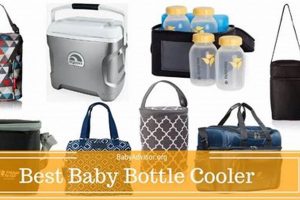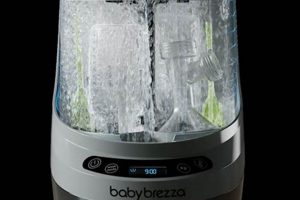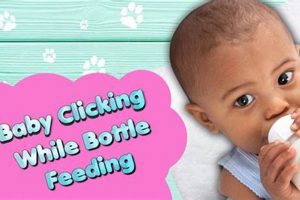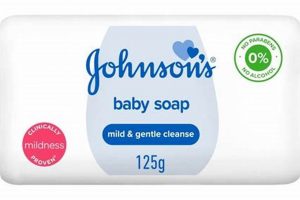Identification stickers affixed to infant feeding containers intended for use in childcare settings are crucial tools. These adhesive products typically display the child’s name, date, and any specific feeding instructions, ensuring proper bottle allocation and minimizing potential errors. For example, a bottle prepared with expressed breast milk must be clearly marked with the baby’s name and the date it was pumped for safe and effective use at a daycare facility.
The use of these identifiers offers significant benefits to both the childcare provider and the parents. They prevent accidental bottle swaps, reducing the risk of allergic reactions or transmission of infections. Furthermore, they support accurate record-keeping and adherence to individual feeding plans, contributing to the health and well-being of the infant. While simple in concept, the consistent application of these labeling methods has evolved into a standard practice, reflecting an increased awareness of safety and hygiene protocols in early childhood education.
The following sections will delve into the different types available, best practices for their application, and considerations for choosing the most suitable option for a daycare environment. This will cover durability, material safety, and compliance with relevant regulations to ensure proper use and maintain a safe and organized childcare environment.
Essential Guidelines for Identifying Infant Feeding Containers in Childcare Facilities
Adhering to best practices for affixing identifiers to infant feeding receptacles is essential for maintaining safety and accuracy in daycare settings. Consistent and informed application minimizes errors and promotes the well-being of the children.
Tip 1: Select Durable and Safe Materials: Opt for labels constructed from waterproof, tear-resistant, and non-toxic materials. This ensures legibility throughout the daycare day and prevents harmful chemicals from leaching into the bottle contents. Avoid materials containing BPA, phthalates, or lead.
Tip 2: Clearly Indicate Essential Information: The label must display the childs full name, the date the bottle was prepared, and any specific instructions, such as feeding volume or allergies. Use a permanent, smudge-proof marker to ensure information remains legible even with moisture exposure.
Tip 3: Position the Label Strategically: Place the label on a smooth, easily visible surface of the bottle, away from areas prone to excessive handling or condensation. Avoid covering measurement markings on the bottle to ensure accurate feeding.
Tip 4: Adhere to Daycare Policy: Familiarize with and strictly follow the daycare’s specific guidelines for identification procedures. This includes any required labeling protocols, authorized pen types, and specified label placement.
Tip 5: Implement a System for Label Removal: Establish a clear protocol for removing old stickers from the bottles immediately after use and cleaning. This prevents confusion and ensures that only current feeding instructions are visible.
Tip 6: Use Color-Coding to indicate the child’s age: Implement color-coded identifiers to distinguish bottles of different age groups, it can helps the caregiver easily find the bottle. This method improves the facility’s efficiency and decreases incidents of errors.
Tip 7: Consider Pre-Printed Labels: Opt for customizable, pre-printed options. These can enhance clarity and professionalism and may include pre-formatted fields for easy completion.
Following these guidelines helps to create a safer and more organized environment within daycare settings, minimizing the risk of errors and promoting accurate record-keeping.
The next section will address regulatory considerations and legal requirements related to proper bottle labeling in childcare facilities.
1. Identification Accuracy
Identification accuracy, when specifically applied to infant feeding bottles within a daycare environment, refers to the precise and unambiguous labeling of each bottle to correspond directly to the intended infant. The accuracy of the labels has a direct impact on the safe and appropriate feeding of each child, minimizing potential risks such as allergic reactions or the inadvertent administration of incorrect feeds. For example, a bottle prepared with hypoallergenic formula must be definitively distinguished from standard formula to prevent an allergic reaction in a sensitive infant. The consequences of misidentification can range from mild discomfort to severe health complications, underscoring the importance of meticulous labeling practices.
The selection and application of these identifiers play a pivotal role in achieving identification accuracy. Daycares need to adopt labeling systems that are not only clearly legible but also resistant to degradation from washing and handling. A typical example is using thermal labels with permanent markers, as these resist smudging and withstand repeated sterilization processes. Furthermore, a well-defined protocol for labeling, including a system for double-checking the labels against the child’s information sheet, is essential to minimize human error. Electronic scanning systems can add another level of identification accuracy, linking labels directly to digital records for improved traceability.
In conclusion, the correlation between labels and proper care in infant daycare environments is paramount. The implementation of precise, verifiable labeling practices significantly reduces the risk of feeding errors. Therefore, the investment in robust labeling systems and rigorous adherence to established protocols is critical for ensuring infant safety and well-being within a daycare setting.
2. Material Safety
Material safety is of utmost importance in the context of identifiers applied to infant feeding bottles within a childcare setting. The substances comprising the labels and adhesives must not pose any risk of chemical leaching or toxicity to the infant. Selecting compliant labels is essential to safeguard infant health.
- BPA and Phthalate-Free Materials
The utilization of Bisphenol A (BPA) and phthalate-free materials in the creation of these labels is crucial. BPA and phthalates are chemicals that have been linked to potential endocrine disruption and adverse health effects, particularly in infants. Adopting labels explicitly certified as free from these substances minimizes the risk of chemical exposure through direct contact with the bottle’s surface. Labels are often made of polypropylene, polyethylene, or vinyl, and are deemed safe if they are certified to be free of harmful chemicals.
- Non-Toxic Adhesives
The adhesive used to affix the identifiers must also be non-toxic and food-grade compliant. Infants may come into contact with the label, increasing the risk of ingestion. Adhesives must adhere effectively without breaking down or releasing harmful chemicals into the bottle’s contents. Acrylate-based adhesives are commonly used due to their strong adhesion and low toxicity profiles when properly manufactured.
- Waterproof and Durable Properties
The chosen materials should exhibit waterproof and durable properties to withstand repeated washing and sterilization cycles. Labels that degrade or peel during these processes present a choking hazard and may compromise the label’s legibility. Materials such as polyester films or specialized synthetic papers provide the necessary resistance to water, heat, and abrasion encountered in daycare environments.
- Compliance Certifications
Labels intended for infant feeding bottles should possess compliance certifications from recognized regulatory bodies, such as the Consumer Product Safety Improvement Act (CPSIA) in the United States or similar standards in other regions. These certifications ensure that the labels have undergone rigorous testing to meet specific safety requirements, providing daycare providers with assurance regarding the product’s safety profile.
In conclusion, the selection of identifier materials requires careful consideration of their chemical composition, adhesive properties, and durability. Opting for BPA and phthalate-free materials, non-toxic adhesives, and labels with appropriate certifications mitigates potential health risks and supports a safe and hygienic feeding environment within the daycare facility.
3. Adhesive Durability
Adhesive durability is a critical factor in the effectiveness and safety of labeling systems for infant feeding containers in daycare facilities. The ability of a label to remain securely affixed and legible through repeated washing, sterilization, and handling directly impacts the accuracy and reliability of bottle identification.
- Resistance to Washing and Sterilization
Labels on baby bottles in daycare settings are subjected to frequent and rigorous cleaning processes. The adhesive must withstand multiple cycles of washing with soap and water, as well as sterilization procedures involving high temperatures and chemical disinfectants. A failure to maintain adhesion through these processes can lead to label detachment, rendering the bottle unidentifiable and potentially leading to feeding errors.
- Adherence to Various Bottle Materials
Infant feeding containers are constructed from a variety of materials, including plastic (polypropylene, polyethylene), glass, and silicone. The adhesive must exhibit strong adhesion to these diverse surfaces, accounting for differences in surface energy and texture. An adhesive that is suitable for one material may fail to adhere adequately to another, necessitating careful selection based on the specific bottle types used in the daycare.
- Resistance to Moisture and Temperature Fluctuations
Baby bottles are routinely exposed to fluctuations in temperature and humidity, both during preparation and storage. The adhesive must maintain its integrity under these conditions, resisting degradation or loss of adhesion due to moisture penetration or temperature-induced changes in its physical properties. This is especially important for bottles stored in refrigerators or freezers, as well as those that undergo warming or sterilization processes.
- Long-Term Adhesion Performance
Labels often need to remain affixed to bottles for extended periods, from the time of preparation to the time of feeding and subsequent cleaning. The adhesive must exhibit long-term adhesion performance, maintaining a secure bond over time without peeling, curling, or losing legibility. This requires the adhesive to resist degradation from environmental factors such as UV exposure and oxidation, ensuring that the label remains intact and readable throughout its intended lifespan.
In summary, the adhesive’s ability to withstand the demands of a daycare environment is essential for ensuring the accurate and safe feeding of infants. Selection of labels with high adhesive durability is a key consideration for daycare providers, contributing directly to the overall safety and organization of their feeding protocols.
4. Legibility Permanence
Legibility permanence, in the context of labels for infant feeding bottles used in daycare facilities, pertains to the sustained readability of information printed on the label throughout its intended lifespan. The importance of maintaining clear and easily decipherable text is paramount for accurate feeding practices and preventing potential errors.
- Ink and Print Quality
The selection of appropriate inks and printing methods directly influences the longevity of label legibility. Inks must be resistant to fading, smudging, and degradation when exposed to moisture, temperature fluctuations, and chemical cleaning agents commonly used in daycare settings. Thermal transfer printing, for example, offers superior durability compared to inkjet or laser printing, due to its resistance to environmental factors. High-resolution printing ensures that even small text, such as dates and times, remains legible.
- Material Resistance to Abrasion
Labels are subjected to frequent handling, which can lead to abrasion and subsequent loss of legibility. The label material should possess inherent resistance to scratching and wear. Lamination or the use of specialized coatings can provide an additional layer of protection against physical damage. For example, a polyester label with a protective overlaminate is more likely to maintain legibility than a paper label without any protective coating.
- Resistance to Chemical Exposure
Daycare environments necessitate the use of sanitizing and cleaning agents to maintain hygiene standards. Labels must be able to withstand exposure to these chemicals without compromising the integrity of the printed information. Certain chemicals can cause inks to dissolve or fade, rendering the label illegible. Testing the labels with commonly used cleaning agents is crucial to ensure long-term legibility in the daycare setting. If alcohol is used to clean the bottles, the label should be able to survive this process.
- Adherence to Best Practices for Application
Proper application techniques can significantly impact legibility permanence. Ensure the label is affixed to a clean, dry surface to promote optimal adhesion and prevent air bubbles or wrinkles, which can distort the printed information. Avoid placing the label in areas prone to excessive abrasion or contact with bottle nipples. The proper storage conditions, away from direct sunlight and extreme temperatures, can also prolong the legibility of the label.
The sustained legibility of labels on infant feeding bottles in daycare environments is not merely a matter of aesthetics; it directly contributes to the safety and well-being of the children in care. By selecting durable materials, employing robust printing methods, and adhering to best practices for application, daycare providers can ensure that labels remain legible and effective throughout their intended use. Doing so contributes significantly to the reduction of feeding errors and the maintenance of a safe and organized childcare environment.
5. Regulatory Compliance
The intersection of regulatory compliance and infant feeding bottle identifiers within a daycare environment represents a critical facet of child care operations. Regulatory compliance mandates adherence to specific guidelines and standards set forth by local, state, and federal agencies, ensuring the health and safety of children in care. Failure to comply with these regulations can result in penalties, legal repercussions, and, most importantly, compromised child welfare. For instance, many jurisdictions require specific information to be included on bottle labels, such as the child’s name, the date of preparation, and any specific feeding instructions, including allergen information. These mandates are designed to prevent errors in feeding and ensure that each child receives the appropriate nutrition and care.
The practical significance of understanding and implementing regulatory requirements regarding bottle labels is substantial. Daycare facilities must establish clear protocols for labeling bottles, train staff on proper procedures, and regularly audit their systems to ensure ongoing compliance. For example, facilities might use standardized label templates that include all required information, conduct regular staff training sessions on labeling protocols, and implement a system for verifying labels against individual child care plans. Furthermore, they must maintain accurate records of feeding schedules and any special instructions, linking these records to the corresponding labeled bottles. These practices not only demonstrate a commitment to regulatory compliance but also enhance the overall safety and efficiency of the daycare operation.
In conclusion, regulatory compliance is not merely a procedural formality but an essential component of responsible child care. By adhering to established standards for bottle labeling, daycare facilities safeguard the health and well-being of the children in their care and minimize the risk of errors or adverse incidents. Ongoing monitoring and adherence to the evolving regulations, including label materials and printing methods, are the responsibilities of a daycare facility, for a safe operation.
6. Allergen Awareness
The presence of food allergies among infants necessitates stringent protocols within daycare settings. The connection between allergen awareness and labels for infant feeding bottles is both direct and critical. Labels on bottles must clearly and conspicuously identify the presence of any allergens, such as milk, soy, or nuts, in the bottles contents. Failure to accurately indicate allergens can result in severe allergic reactions, potentially leading to anaphylaxis and requiring immediate medical intervention. The accurate inclusion of allergen information is not merely a best practice but a fundamental safety requirement.
Effective implementation of allergen awareness through labeling requires a multi-faceted approach. Firstly, daycare facilities must maintain detailed records of each childs known allergies and dietary restrictions. These records should inform the preparation and labeling of each bottle. Secondly, labels should use standardized symbols or text to clearly indicate the presence of specific allergens, minimizing ambiguity and ensuring that all caregivers understand the information. For example, bottles containing cows milk formula might display a prominent Contains Milk warning, while those with soy-based formula could feature a “Contains Soy” symbol. The use of color-coding, with different colors representing different allergen categories, can further enhance visibility and reduce the risk of errors. It has to withstand the bottle washer to be effective.
In summary, allergen awareness constitutes a vital component of labeling procedures for infant feeding bottles in daycare environments. Clear and accurate communication of allergen information mitigates the risk of allergic reactions and promotes the health and safety of infants with food allergies. A combination of comprehensive record-keeping, standardized labeling practices, and ongoing staff training is essential for ensuring that allergen awareness is effectively integrated into all aspects of infant feeding within the daycare setting. Facilities have to follow the protocols, since there are severe liabilities if not.
7. Tamper-evident design
Tamper-evident design, when applied to identifiers affixed to infant feeding bottles within a daycare setting, directly addresses the critical need for ensuring the integrity of the bottle’s contents. These design features serve as visual indicators if the bottle has been opened or altered after preparation. The implementation is important because it gives assurance that the bottle’s contents remain as originally intended, free from external contamination or unauthorized modifications. For instance, if a pre-prepared bottle has a broken seal or a disrupted identifier, it indicates that the contents may have been compromised and the bottle should not be used.
Considerations within tamper-evident solutions range from using special adhesives that irreversibly distort upon label removal to integrating security cuts or perforations into the label material. Implementing holograms or unique serial numbers can also serve this purpose. Daycare facilities may employ bottles with shrink-wrap bands over the lid to provide a clear indication of tampering. The effectiveness of these measures hinges on proper training of daycare staff to recognize and respond to any evidence of tampering, ensuring that potentially compromised bottles are immediately identified and removed from use. Using a one-time use label is also a practical option.
In conclusion, tamper-evident design is a vital component of comprehensive safety protocols for baby bottles in daycare. By visually signaling potential contamination or alteration, these features empower caregivers to make informed decisions, safeguarding infant health and well-being. Integrating robust tamper-evident features into labeling practices demonstrates a commitment to maintaining the highest standards of hygiene and security within the childcare environment.
Frequently Asked Questions Regarding Infant Feeding Bottle Identification in Childcare Settings
The following questions address common concerns regarding labeling systems for infant feeding bottles, ensuring clarity and promoting adherence to best practices in daycare environments. The answers provided are intended to offer accurate and informative guidance.
Question 1: Why is proper identification of infant feeding bottles essential in daycare facilities?
Proper identification is critical for preventing errors in feeding, reducing the risk of allergic reactions, and ensuring each infant receives the correct formula or breast milk. It also supports accurate record-keeping and adherence to individual feeding plans.
Question 2: What information must be included on identifiers affixed to infant feeding containers?
Identifiers should display the child’s full name, the date the bottle was prepared, and any specific feeding instructions, such as volume, allergies, or special formula requirements. This assures the daycare takes the correct measures for the child.
Question 3: What material properties should identifiers possess to ensure safety and durability?
Identifiers must be constructed from non-toxic, waterproof, and tear-resistant materials. The adhesive should be food-grade compliant and capable of withstanding repeated washing and sterilization cycles. The material should not easily degrade or cause a choking hazard. The label must be resistant to smudging.
Question 4: What are the consequences of failing to adhere to regulatory guidelines for labeling infant feeding bottles?
Non-compliance with regulatory guidelines can result in penalties, legal repercussions, and potential compromise of child welfare. Strict adherence to labeling standards mitigates the risk of feeding errors and protects the health and safety of infants.
Question 5: How does allergen awareness factor into the labeling of infant feeding bottles?
Identifiers must clearly and conspicuously indicate the presence of any allergens in the bottle’s contents. Standardized symbols or text should be used to minimize ambiguity and ensure caregivers understand the information, thereby preventing allergic reactions. The caregiver must follow these guidelines for the benefit of the child.
Question 6: What measures can be taken to ensure the bottle has not been tampered with?
Tamper-evident designs, such as special adhesives that distort upon label removal, security cuts, or shrink-wrap bands, can provide visual indication if the bottle has been opened or altered. These features promote confidence in the integrity of the bottle’s contents.
In summary, accurate identification, durable materials, adherence to regulations, and allergen awareness are all essential components of effective labeling practices for infant feeding bottles in daycare settings. The ultimate goal is to promote infant health and safety by minimizing the risk of feeding errors and ensuring the provision of appropriate care.
The subsequent sections will delve into specific product recommendations and provide practical guidance for implementing comprehensive labeling solutions.
Baby Bottle Labels for Daycare
This exploration of baby bottle labels for daycare underscores their vital role in maintaining a safe and organized childcare environment. Accurate identification prevents feeding errors, minimizes allergic reactions, and supports regulatory compliance. Durable materials, legible printing, and tamper-evident designs are essential for effective label performance.
The consistent and conscientious application of proper labeling practices is paramount. Childcare facilities must prioritize adherence to established protocols and invest in robust labeling systems to safeguard infant health and well-being. Prioritizing these measures is a fundamental responsibility in childcare.







